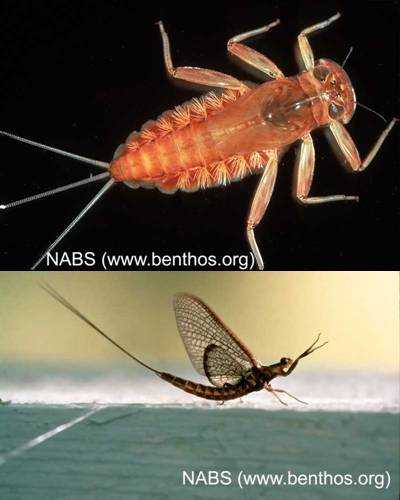Home → Water Quality → Monitoring & Reporting → Biomonitoring → Sampling & Analysis → Macroinvertebrate Types → Mayfly
 Mayfly Larvae (Ephemeroptera)
Mayfly Larvae (Ephemeroptera)
Mayflies are a type of insect that spends its juvenile life in the water and its adult life in the air and on land. Adult mayflies lay their eggs in the water. When mayfly larvae hatch from these eggs they look essentially like adults with no wings. Each time they shed their skin they look a bit more like an adult mayfly. This type of life history is called incomplete metamorphosis.
Larval mayflies, like all aquatic insect larvae with incomplete metamorphosis, have three body segments and six legs. They are usually 2-32mm in length, and can be distinguished from other aquatic insect larvae by the delicate gills on the sides of the abdomen and their 2-3 tails. Mayflies spend most of their lives in larval form. Adults live anywhere from 90 minutes to a couple of days, during which time they don't feed. Their primary activity as adults is mating to produce more aquatic mayfly larvae.
Most mayflies either feed on decaying plants and detritus or on live algae scraped from the substrate. Mayflies can be found in a wide variety of habitat types, although individual species may have specific requirements. They are most commonly found on firm substrate in streams and lake littoral zones, but some are adapted for soft substrate.
Mayflies are very sensitive to pollution, and as such are usually only found at high quality, minimally polluted sites. Along with caddisflies and stoneflies, they are one of the three most commonly used indices of aquatic ecosystem health. Because they are found in a wide variety of habitats and are so widely sensitive to pollution, they are a valuable indicator of water pollution. Their presence in an aquatic ecosystem is a strong indicator of a healthy body of water.
Picture key
Top: Mayfly larva (Heptageniidae)
Bottom: Adult mayfly
Source: The North American Benthological Society
Bibliography
Voshell, Jr., J. Reese; illustrated by Amy Bartlett Wright. 2002. A Guide to Common Freshwater Invertebrates of North America. Blacksburg (VA): The McDonald & Woodward Publishing Company. 442 p